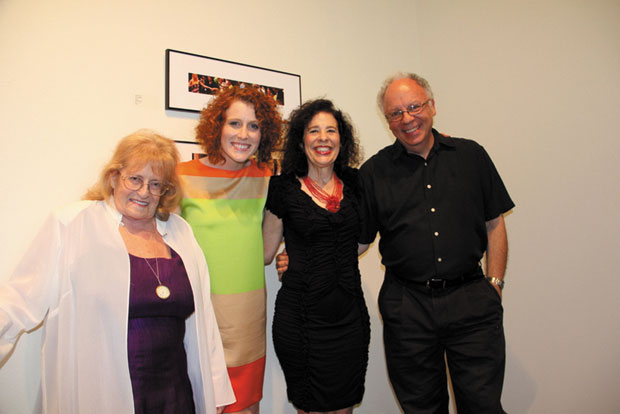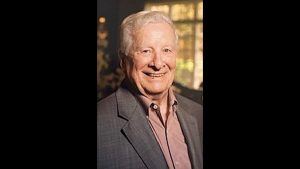Exhibit explores contemporary Jewish art with works by four local artists
Published August 8, 2012
An ongoing exhibition at the Regional Arts Commission examines themes of contemporary Jewish art through the works of four local Jewish artists: Sandy Kaplan, Lauren Pressler, Frank Roth, and Barbara Umbogy.
Buzz Spector, himself an artist, is curator of the show. It encompasses a wide range of media, from Roth’s photographs and Umbogy’s paintings to Kaplan’s terra cotta vessels and Pressler’s installation.
ADVERTISEMENT
Spector is 64 and married with three children and lives in University Hills. Kaplan has two daughters and lives in Richmond Heights. Pressler, 26, resides in the Central West End. Umbogy lives in Webster Groves and has six children. Roth, 84, is married with three children and lives in University City.
The Light sat down with Spector and the four artists to parse the complexities of the show. We included selected responses below — to read the full interviews with each of the artists, visit stljewishlight.com/artists.
Tell us about the title of the show, “TRADITION! (As uttered by Zero Mostel in ‘Fiddler on the Roof’).
Spector: Much of the work in the show is not what people would think of as traditional Jewish art, so I made a consciously ironic choice to name the show “TRADITION!”
As artists, where do you get your ideas?
Roth: They come to me on the spot. I respond to what’s going on around me.
Spector: Ideas are not yet knowledge, so simply having them isn’t enough. Everyone needs to act on ideas – that’s where the learning takes place. Ideas come from the intersection of past experience and new encounters.
ADVERTISEMENT
Umbogy: Ideas come to me complete. I get them everywhere, all the time. If I don’t see ideas in my mind, I can’t paint them. Art is like memorials of special things – the arrangement of trees or the way two people face each other.
Kaplan: Originally, the ideas of vessels with people on them came from art I saw in a gallery in Michigan. I was inspired by figures of women sculpted around a vessel. I started creating vessels with women at tea, in conversation and friendship, modeled after European café culture.
Later on, I sculpted men and women with dance, music, love, and passion incorporated into the narrative of the vessel. Whenever I would see art, whether a painting or other media, I would picture the images as a vessel with figures and create a sculpture enhancing the narrative of the piece with my own style.
I was interested in ceramics years before I took a clay handbuilding class at Craft Alliance in 1989. I created ceramic planters as well as other crafts like needlepoint, sewing, watercolor, and knitting. Since my very first class, I’ve been working with clay nonstop. I loved the feeling of terra cotta clay and found it very easy to work with.
Pressler: My earlier ideas were heavily research-based, with a lot of reading and writing. More recently, I collect objects I’m attracted to. I generally work them into a piece after I collect them. For my installation piece Spears into Pruning Shears, I knew I wanted specific items like hawk and dove feathers. Most of the time I’m not driven by a specific concept; my interests are more experimental.
The book The Holocaust in American Life gave me the idea for Spears into Pruning Shears and I saw the opportunity to do a literal reading of the quote about hawks and doves in the book. This duality is inherent to Jews but also intrinsic to every person. The title of my piece is a biblical reference in Isaiah: spears refer to war and pruning shears to agriculture in times of peace.
What was a seminal experience for you as an artist?
Kaplan: I’ll never forget when I saw Michelangelo’s David in Florence. My mouth dropped open at seeing this massive and beautiful figure. I was influenced by Israeli artists who did watercolors of women with undefined faces. While vacationing in San Francisco, I went to the Palace of Fine Arts and studied and sketched the faces of Greek women statues to learn how to sculpt faces. In a Vancouver restaurant I saw a mural which inspired my piece Dancing ’Til Dawn. I’ve also been commissioned to create special pieces for people.
Pressler: I was raised in and around art my whole life. My grandmother was a professional artist and very influential. Going abroad was huge for me, especially to Paris and my grandfather’s native country of Austria.
Umbogy: Doing my son’s portrait was one experience, because he died of cancer. He went to Eureka High School and I created a 6’ x 8’ version of the school mascot and gave it to the school in his memory. Also, growing up in New York City affected me very strongly. My favorite thing to do was sit in the Rembrandt room at the Metropolitan Museum of Art. At that time, you could travel on the subway as a kid and I’d go to the Met or the Art Students’ League and draw.
Spector: The moment I became an artist was during my senior year of college. I read an article about Robert Ryman, a painter of all-white paintings, and thought to myself, That’s not art. I always blamed things that I didn’t understand on my own ignorance. When I realized this wasn’t art, I knew I could imagine what could be art. As it has evolved, my encounter with Ryman has changed in my mind and now I think he’s a great artist.
Roth: Teaching. I taught at the School of Art at Washington University for 40 years, principally night school. I really loved teaching freshmen in the courses of The Language of Vision, and Drawing.
Which artists inspired you?
Pressler: Rina Banjer, a sculptural artist. Jean-Paul Rubens – I love Rubens. He’s one of my favorite painters; the confidence of his brushwork is inspiring. I also really like some architects and designers.
Umbogy: The Russian impressionists have been my favorite artists for a long time. Isaac Levitan slept on a bench in a train station so he could continue his art studies. I like everything from the cave paintings to the modernists.
Kaplan: My early work was inspired by Itzchak Tarkay and Isaac Maimon who do watercolors; Marc Chagall; and Tamara de Lempicka, who fled the Russian Revolution to Paris in the 1930s and became a famous painter. My most recent inspirations have come from David Schluss’ paintings which are more contemporary with a flair for music, movement, and vibrant colors.
Roth: Edward Hopper and Margaret Bourke-White. I was thinking of a career in photography before I attended Washington University. I saw Bourke-White’s Life Magazine photographs and thought, If I’m going to be a photographer, those are the kind of photos I want to take. When I retired six years ago, I started taking pictures seriously.
Spector: Robert Ryman, Paul Cézanne, Matisse; many writers, including Borges, Kafka, and Barthes; and philosophers including Spinoza, Ralph Ellison, and Susan Sontag.
Which themes does your work address?
Spector: The dialog between public history and personal memory, and crucially how material conditions evoke both loss and presence. That’s pretty Jewish. The Wailing Wall might be the ultimate artifact of that question.
Pressler: I’ve done a lot of work on Jewish identity but I think my interest in body politics is more primary. Body politics refers to our relationship to our body. I’ve been interested in corsets; anatomical drawings; medicine; and Victorian mourning culture, in contrast to our sanitized, clinical experience of death in contemporary American culture.
Roth: Visual patterns; the relationship of the subject to the background. I’m interested in negative and positive shapes. My personal challenge is how to make the space work in every photograph. Everything in the picture plane has to work together.
Kaplan: The themes of my work capture women and men in friendship, in love…some of life’s beautiful feelings of happiness, elation, passion, joy, and love along with movement, song, and dance. Some themes are more specific if I am working on a commission based on direct requests from my client. Other themes have come from my love of nature…the outdoors…the beach. When I come across a painting or sculpture that I’m drawn to, I will visualize a theme for creating a new sculpture.
Umbogy: Personal themes – the idea is to pull the viewer into the painting to participate in the art.
What is your dream project?
Kaplan: I’d like to get back to doing larger and freestanding pieces. I did Tango without a vessel, and it was a challenge to sculpt it because of all the movement in the piece. I made a piece of Adam and Eve in the Garden that was freestanding and over three feet tall.
Umbogy: I want to tell the story of my life in paintings, so that other people can understand what I’ve learned without having to go through it themselves.
Spector: I don’t favor that line of thought. It tends to move what’s in front of you to an ideal destination. You have to respect the value of the work in front of you. I knew a Chicago artist who described a simple task: to make each work better than the one before it. The problem with his quest was its idealization, which prevented him from dealing with the work in front of him. His regret was chilling and instructive.
Roth: I don’t have one. If I did, it would be to get an interesting assignment where I’d have to use my imagination to solve it. Right now, I create my own problems to solve.
Pressler: I’ve been thinking about this ever since the tsunami in Japan. I want to drape a huge piece of fabric from the viewing platform of the Arch down to the ground, in the style of Christo and Jeanne-Claude. The Arch would physically and theoretically frame the fabric, which could stand for a giant banner, a sail, practically anything. It would announce St. Louis’ art presence.
How does being Jewish influence your work?
Kaplan: I have a real sense of the Jewish community, of connecting with people. I’ve worked in the Jewish community for a long time – the Anti-Defamation League, the Jewish Federation, Barnes-Jewish Hospital, and Congregation B’nai Amoona. Being Jewish comes through in my work as it is the essence of all my creations.
Pressler: I’m attracted to family heritage in general, because I see this continuity from how our grandparents were raised to how our parents were raised and we were raised. I had my grandfather’s letters and journals translated – letters he wrote to his parents who were in a ghetto in Poland, and journals about his life in Europe.
Umbogy: It’s a great responsibility to be Jewish. Combining that with your work, you want to do it wonderfully. There’s an aspect that this is who I am and what I am; it’s a part of me.
Spector: I tend to answer questions with other questions. I think my use of ambiguity has a cultural basis.
Roth: I’m not sure how to address that. I’m not interested in Jewish content so much as the attitude of the work, which is emotional. It’s being sensitive to what’s going on around you, which I think is a Jewish trait.

















